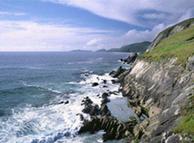Unesco World Heritage Sites: A refuge of early Christianity - Skellig Islands in Ireland
From a distance the Skellig Islands appear to be little more than jagged rocks rising out of the stormy Atlantic, eight miles off the West Coast of Ireland. One of the islands, Small Skellig, has always been uninhabited and is a bird refuge, known for its huge colony of gannets. The other, Skellig Michael, is an Unesco World Heritage Site where Irish monks built a monastery sometime between the sixth and ninth centuries. There are more than 20 island monasteries off the Irish coast, but none is so remote and difficult to reach, which is why it remained almost unchanged for more than 1000 years.
Contents[hide] |
Little Skellig
The smaller island is Little Skellig (Sceilig Bheag in Irish). It is closed to the public, and holds Ireland's largest and the world's second-largest Northern Gannet colony, with almost 30,000 pairs. It is about 1.5 km east of Great Skellig.
Great Skellig
Also known as Skellig Michael (Sceilig Mhichíl in Irish), this is the larger of the two islands, rising to over 230 m above sea level. With a sixth-century Christian monastery perched on a ledge close to the top, Great Skellig is designated as a UNESCO World Heritage Site.
Wildlife
Both of the Skellig islands are well known for their seabird colonies, and together comprise one of the most important seabird sites in Ireland, both for the population size and for the species diversity.
Among the breeding birds are European Storm-Petrels, Northern Gannets, Fulmars, Manx Shearwaters, Black-legged Kittiwakes, Common Guillemots, Razorbills and Atlantic Puffins (with 4000 or more puffins on Great Skellig alone). Smaller numbers of Choughs and Peregrine Falcons can also be seen.
The surrounding waters teem with life also.
External links
- UNESCO World Heritage Centre - Skellig Michael
- A Project Web Site about The Skellig Islands
- Skelligs Islands - A website detailing information about visiting the islands
- SkelligsRock - A website detailing the islands history and wildlife


沒有留言:
張貼留言